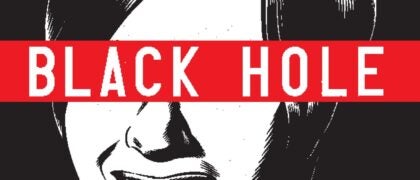On June 25, 1947, the first edition of Anne Frank’s The Diary of a Young Girl was published. Anne’s diary had been found after she died of typhus in 1945 in the Bergen-Belsen concentration camp, and given to her father, Otto Frank, the only known surviving member of her family. Since its original publication, the Diary has been published in more than 70 languages, taught to children across the globe, banned, championed, adapted for the theater and the silver screen, and, of course, turned into a graphic novel.
In Anne Frank’s Diary: The Graphic Adaptation, Ari Folman and David Polonsky—the Academy Award–nominated duo that created Waltz with Bashir—bring Anne’s indelible story to a new audience of readers young and old. Authorized by the Anne Frank Foundation in Basel, this is the first graphic novel edition of the Diary, quoting extensively from the original text while employing imaginative and stunning illustrations to interpret and add layers of visual meaning to this timeless classic.
As this June marks the 75th anniversary of the original publication of the Diary, it’s the perfect time to dive into the graphic adaptation and engage with the remarkable text in a whole new way. Keep scrolling to sneak a peek at the incredible artwork featured within.
- ANNE: No one would believe me, but at the age of 13, I feel totally alone in this world. I have loving parents and a 16-year-old sister. MARGOT: What ar e you waiting for, Anne? Come and open your presents! ANNE: Hanneli and Jacqueline are supposedly my best friends, but I’ve never had a real friend. JACQUELINE: She does like to be the center of attention, doesn’t she? ANNE: I have a throng of admirers who can’t keep their adoring eyes off me. ROB: Anne! Come down! I can’t live without you! OTTO: Rob, go home!! I swear I’m going to call the police!
- ANNE: All I think about when I’m with friends is having a good time. I can’t bring myself to talk about anything but ordinary everyday things. Much as I try, I can’t get any closer to people. that is why as soon as I saw you among my other presents, I knew you were special! So you are going to be the closest friend I never had in my life and I’m going to call this friend Kitty. Dear Kitty, I hope I will be able to confide everything to you, as I have never been able to confide in anyone, and I hope you will be a great source of comfort and support.
- ANNE: I’d better provide a brief sketch of my life. My father and mother married in Germany in 1925. It was not love at first sight… OTTO: Does it bother you that I am much older? EDITH: How would I know? You’re my first one. ANNE: My sister Margot was born in 1926. OTTO: Isn’t she the prettiest baby ever? EDITH: You shouldn’t say that, darling. It’ll bring bad luck. ANNE: I came into the world three years later: Annelies Marie Frank. OTTO: Goodness, she’s even prettier than her sister! EDITH: You’ll bring bad luck again if you say that! OTTO: According to whom? EDITH: To us Jews of course! ANNE: Being Jewish was not so important in our home. Mother did come from a traditional background, but we kept things religion-free. But then the Nazis came along and defined us Jews as different after all. MARGOT: Does this veterinarian only treat Jewish animals? EDITH: No… but he is treated like an animal only because he is Jewish. ANNE: When the Nazis came to power, their aim was to remove the Jews from German society. Even though Jews were less than 1% of the population, the Nazis believed we were the root of all evil. OTTO: All my Jewish friends in the civil service have been fired. This will only get worse. It’s time to make a move.
- ANNE: Believing Holland was safe for Jews, Father moved to Amsterdam in 1933 to run Opekta, a company that manufactures a secret stabilizer for jam. Mother and Margot followed a while later, while I stayed in Germany with Grandma. On Margot’s 8th birthday, I came from Germany as a surprise present, and our family was finally reunited. Life in Holland was beautiful. We had such freedom! We went ice-skating all the time, and even took ski holidays in the Alps. the bad signs of what was about to happen began when uncle Uli came from Hamburg. He had fled from Germany, and he told us how horrific life had become for Jews there. Nazis burned down synagogues and Jewish-owned shops, and smashed their windows. They also burned books that were about Jewish culture or written by Jews. Jews were fleeing, finding shelter wherever they could. ULI: There are rumors of a labor camp in Dachau, where the Nazis send anyone who isn’t “German enough.” ANNE (thinking): But what do they do to those people there?















